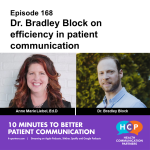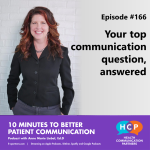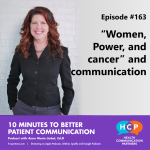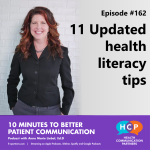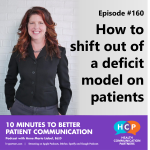In today’s episode, I talk about time with otolaryngologist and podcast host, Dr. Bradley Block. He shares some of what he’s learned about efficiency in patient communication. Time. It’s the ultimate constraint on any interaction. In today’s episode, I talk with otolaryngologist and podcast host, Dr. Bradley Block. He shares some of what he’s learned […]
Patient Centered
Episode 166 Your top communication question, answered
I share the most common question I get asked as a communication expert. I tell you how I answer, and break down why it works. No matter what your role is as a health professional, what your specialty or topic is, or who your audience is, this episode is about the single best piece of […]
This may change the way you think about patient education
This week, a client was telling me about a talk she’d attended at a recent DEI conference. There was disappointment, but a sense of resolve in her voice, as she told me about this talk. The speaker had cited statistics on how little impact typical trainings have, when it comes to deep issues like unconscious […]
Episode 163 “Women, Power, and cancer” and communication
I look at a recent report from a Lancet Commission on Women, Power, and cancer, and consider where communication comes into it. I finish with something you can do if you’re thinking about power in your communication. Today’s episode is about communication and power. We’re looking at a recent report from a Lancet Commission on […]
Episode 162 11 Updated health literacy tips
Today I open a health literacy time capsule, and talk about what’s changed. 6 years ago, I gave you 11 health literacy tips. Which are outdated? Which stand the test of time? What do I wish I’d said? Find out! It’s health literacy month and our 6th anniversary as a podcast series. So I’m combining […]
Episode 160 How to shift out of a deficit model on patients
There’s a difference between identifying someone’s needs, and regarding the person as being deficient. In this episode, you’ll learn about how common deficit models are in health care some of the damage they can do two things you can do to turn away from a deficit perspective. Do you know what a deficit perspective is? […]

